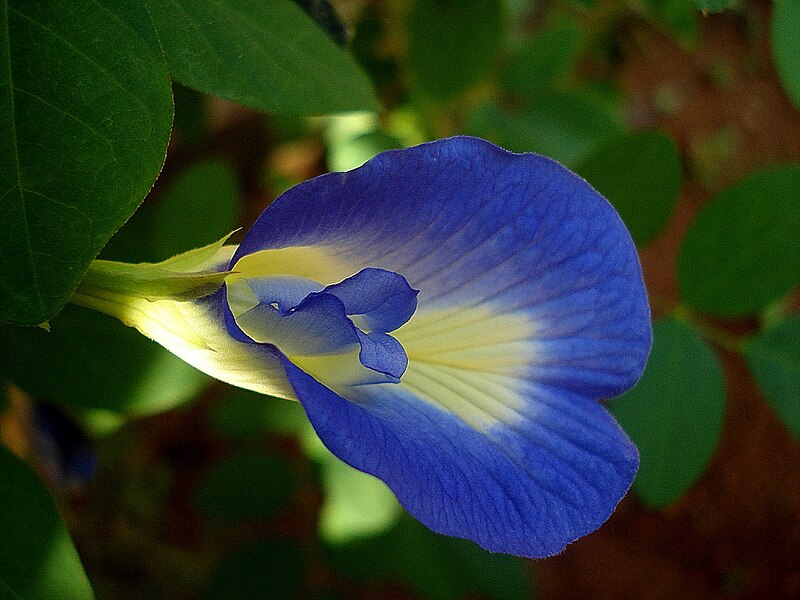Clitoria ternatea
Asian pigeonwings, bluebellvine, blue pea
Västindien. Utsökt exotisk, klängande växt med fjärilslika, högblå blommor med gult öga. Relativt snabbväxande raritet som oftast odlas som bienn eller annuell. Krukodlas mot spaljé eller liknande. Placeras med fördel utomhus på varmt växtläge under sommaren.
ODLING FRÅN FRÖ:
Fröerna ruggas lätt med sandpapper och blötläggs sedan 1 dygn före sådd. Sås inomhus. Planteringsjord blandas med 1/4 torv och 1/4 perlit eller finkornigt grus. Täck fröerna med sand eller perlit. Täck sådden med klar plast försedd med lufthål. Krukodlas och övervintras inomhus.
This plant is native to tropical equatorial Asia, but has been introduced to Africa, Australia and America.
It is a perennial herbaceous plant, with elliptic, obtuse leaves. It grows as a vine or creeper, doing well in moist, neutral soil. The most striking feature about this plant are its vivid deep blue flowers; solitary, with light yellow markings. They are about 4 cm long by 3 cm wide. There are some varieties that yield white flowers.
The fruits are 5 – 7 cm long, flat pods with 6 to 10 seeds in each pod. They are edible when tender.

It is grown as an ornamental plant and as a revegetation species (e.g., in coal mines in Australia), requiring little care when cultivated. As a legume, its roots form a symbiotic association with soil bacteria known as rhizobia, which transform atmospheric N2 into a plant usable form, therefore, this plant is also used to improve soil quality through the decomposition of N-rich tissue.
The butterfly pea (Clitoria ternatea L.) is a vigorous, trailing, scrambling or climbing tropical legume. Its sparsely pubescent stems are sub-erect and woody at the base and may be up to 5 m long. They root only at the tips (Cook et al., 2005; Staples, 1992). The leaves are pinnate, bearing 5-7 elliptical, 3-5 cm long leaflets. The flowers are solitary or paired, deep blue or pure white, about 4 cm broad. The fruits are flat, linear, sparsely pubescent pods that dehisce violently at maturity and throw 8-10 dark and shiny seeds (FAO, 2012; Cook et al., 2005; Staples, 1992). There are numerous ecotypes, agro-types and cultivars that differ in flowers and leaflets (FAO, 2012; Staples, 1992). Many cultivars have been bred in Latin America, notably in Cuba and Mexico (Cook et al., 2005; Villanueva Avalos et al., 2004; Gomez et al., 2003).
Clitoria ternatea grows within 20°N and 24°S, from sea level up to an altitude of 1600-1800 m, and in equatorial Africa up to 2000 m (FAO, 2012; Ecocrop, 2012; Cook et al., 2005; Staples, 1992). Butterfly pea does better where average temperature is about 19-28°C and where annual rainfall ranges from 700 to 1500 mm. However, it tolerates temperatures as low as 15°C and even some frost as it may regrow from the stems or from the plant base, provided it is already woody when the frosting occurs. It does well under irrigation but has only a low tolerance of flooding or waterlogging. It has also some drought tolerance and can grow in places where rainfall is as low as 400-500 mm. It can survive a 5-6 month drought in the drier tropics. Clitoria ternatea can grow on a wide range of soils but is particularly adapted to shallow, heavy clay and sodic soils (pH 5.5-8.9). It thrives in full sunlight but can also grow under light shade in rubber and coconut plantations
Clitoria ternatea is a high-quality, protein-rich legume, a "tropical alfalfa" often referred to as a protein bank that can be grown at low cost (Cook et al., 2005). Livestock tend to prefer it over other legumes and grasses and it is therefore much valued as a pasture legume. It is also used for cut-and-carry feeding systems and cut for hay and silage (Gomez et al., 2003). An N-fixing legume, Clitoria ternatea is used as a ley legume or as green manure. It is a valuable cover crop in rubber and coconut plantations. The young pods are edible and used as vegetables in the Philippines (Staples, 1992). Butterfly pea is used in fences and in trellises as an ornamental for its showy flowers, valuable for dyeing and in ethno-medicine (Cook et al., 2005). All parts of Clitoria ternatea contain peptides called cliotides that have potent anti-microbial properties against Escherichia coli
Poultry
Dried leaves of Clitoria ternatea have been tested with success as a feed diluent for broilers (Marin et al., 2003). However, broiler performance was decreased when it was used as a feed ingredient as a substitute for maize (Monforte et al., 2002).
Rabbits
Clitoria ternatea is a common forage for feeding rabbits in Mozambique and Sudan (Muir et al., 1996; Elamin et al., 2011). When fed ad libitum with fresh Napier grass (Pennisetum purpureum), Clitoria forage could not support rabbit growth. However, when fed ad libitum with green sweet potato vines, Clitoria forage gave a growth rate representing 75% of that observed with growing rabbits receiving the pelleted control diet (Muir et al., 1991). When given to rabbits in addition to a pelleted diet, the voluntary forage:concentrate ratio was 17%:83 % on a DM basis and the growth rate 93% that of rabbits fed pellets only (Muir et al., 1991).

Soil improver and cover crop
Clitoria ternatea is an N-fixing legume and can be used as a ley legume and as green manure. It is also useful in revegetation of coal mining sites in central Queensland (Australia)


Kommentarer
Skicka en kommentar